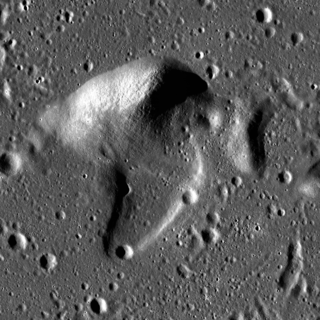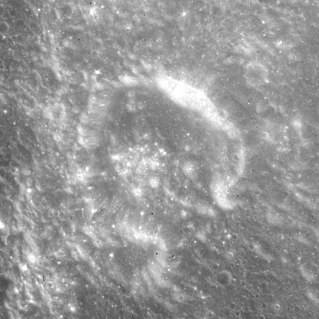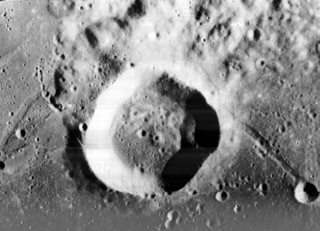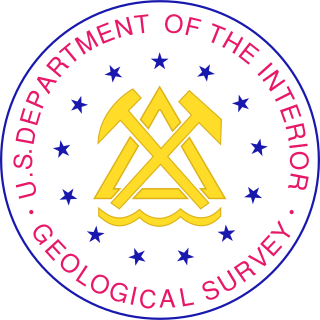
Pupin is a tiny lunar impact crater located in the eastern part of the Mare Imbrium. It was named after Serbian-American physicist Mihajlo Pupin. It lies to the southeast of the crater Timocharis, and was identified as Timocharis K prior to being renamed by the IAU. The mare near Pupin is otherwise devoid of significant impact craters, and is nearly featureless except for a faint dusting of ray material.

Aryabhata, named after Indian astronomer Aryabhata, is the remnant of a lunar impact crater located in the eastern Mare Tranquillitatis. The crater has been almost submerged by lava-flow, and now only an arc-shaped ridge formed from the eastern half of the rim remains above the lunar mare. This crater was previously identified as Maskelyne E before being named by the IAU in 1979. Maskelyne itself is to the southwest.

Carlini is a small lunar impact crater located in the Mare Imbrium. It was named after Italian astronomer Francesco Carlini. The crater is bowl-shaped with a small central floor. It has a higher albedo than the surrounding mare, making it prominent due to its isolated location. To the south is a wrinkle ridge named Dorsum Zirkel, and farther south lies the peak Mons La Hire.

Bobillier is a tiny, cup-shaped lunar impact crater in the southwest part of Mare Serenitatis. It was named after French geometer Étienne Bobillier in 1976. It lies to the north-northwest of the crater Bessel. To the south and west is a wrinkle ridge designated Dorsum Buckland. Bobillier was previously identified as Bessel E.

Zähringer is a small lunar impact crater located near the southeast fringes of Mare Tranquillitatis. To the northeast is the flooded crater Lawrence, and to the southeast are the Montes Secchi mountains and the crater Secchi. Farther to the east lies Taruntius. Zähringer is a circular, bowl-shaped formation with a small interior floor at the midpoint of the sloping inner walls. It is not markedly worn by subsequent impacts.

Amontons is a tiny lunar impact crater in the western half of the Mare Fecunditatis. It is a circular, cup-shaped formation that has been excavated out of the level surface by the impact, and is the same dark hue as the surrounding mare. When the sun is at a low angle, multiple ghost-craters are visible in the mare surface to the south-southeast and north of it.

Al-Bakri is a small lunar impact crater on the northwest edge of Mare Tranquillitatis. It is named after the Spanish Arab geographer and historian Abu Abdullah al-Bakri. It is just south of the eastern arm of the Montes Haemus that borders the Mare Serenitatis to the north. To the east-northeast is the prominent crater Plinius. South of the crater are the rilles of the Rimae Maclear.

Asada is a small lunar impact crater located at the northern edge of Mare Fecunditatis, to the northeast of the crater Taruntius. It is a circular crater formation with inner walls that slope down toward a small central floor at the midpoint. Asada was designated Taruntius A prior to being named by the IAU.

Cameron is a small lunar impact crater that lies across the northwest rim of the crater Taruntius. It was named after American astronomer Robert Curry Cameron, by his wife, lunar specialist Winifred Cameron. This formation is circular and cup-shaped, with no particular distinguishing features. It was previously designated Taruntius C.

Carrillo is a small lunar impact crater located near the eastern limb of the Moon. In this location the crater is subject to lunar libration effects, and appears highly oval due to foreshortening. It is located on the slope of highlands on the west side of Mare Smythii, and its inner wall is wider on the western side than to the east.

Curtis is a very small lunar impact crater that lies in the western Mare Crisium, to the east of the crater Picard. It is a circular, cup-shaped formation that is otherwise undistinguished. It was named after American astronomer Heber D. Curtis in 1973. In the past it was designated Picard Z.

Taruntius is a lunar impact crater on the northwestern edge of Mare Fecunditatis. It was named after ancient Roman philosopher, mathematician and astrologer Lucius Tarutius Firmanus. To the northwest is the lava-flooded crater Lawrence, and to the north lie the craters Watts and da Vinci.

Bohnenberger is a lunar impact crater that lies near the east edge of the Mare Nectaris, in the foothills of the Montes Pyrenaeus mountain range that forms the perimeter of the mare. To the east beyond the mountains is the larger crater Colombo. The crater has a low rim along the north wall, and the floor is somewhat irregular with a ridge crossing the floor. There is a small crater along the western inner wall.

Fedorov is a lunar geologic feature located in the western Mare Imbrium. It was named after Russian rocket scientist A. P. Fyodorov. It lies east-northeast of the crater Diophantus, and southeast of Delisle. About 20 kilometers to the south-southeast is the slightly larger formation of Artsimovich.

Secchi is a small lunar impact crater formation on the northwest edge of Mare Fecunditatis. It was named after the 19th-century Italian astronomer Angelo Secchi. To the northeast is the crater Taruntius. The western rim is joined with a section of the minor Montes Secchi range. The rim of this crater has been opened in the northern and southern ends, leaving two curved ridges facing each other across the crater floor. To the south is a pair of rilles designated the Rimae Secchi. These lie near the edge of the mare, and have a combined length of about 40 kilometers.

Atwood is a small lunar impact crater that is located on the Mare Fecunditatis, to the northwest of the prominent crater Langrenus. It forms a triple-crater formation with Naonobu attached to the north rim and Bilharz near the west rim.

Watts is a small lunar impact crater that is located at the extreme northern edge of the Mare Fecunditatis. It was named after American astronomer Chester Burleigh Watts. Just one crater diameter to the northwest is the irregular da Vinci. Farther to the south is the larger crater Taruntius.

Lawrence is a lunar impact crater that is located on a section of terrain to the east of Mare Tranquillitatis and northwest of Mare Fecunditatis. It was named after American physicist and Nobel laureate Ernest Lawrence and American astronaut Robert Henry Lawrence, Jr.. To the southeast is the larger crater Taruntius. The rille designated Rima Cauchy crosses the eastern part of the Mare Tranquillitatis and reaches as far as the northern rim of Lawrence.

Eckert is a tiny, isolated lunar impact crater in the northern part of the Mare Crisium. This crater forms a circular pit in the dark surface of the surrounding lunar mare. Just to the west is a wrinkle ridge in the mare surface, a feature that is prominent only under oblique lighting from the Sun. The nearest craters of note are Peirce to the west-northwest, and Picard to the southwest. Both of these craters lie in the Mare Crisium basin.

Courtney is a tiny lunar impact crater on the Mare Imbrium, a lunar mare in the northwest quadrant of the Moon. It lies about two crater diameters to the northwest of Euler, in an otherwise isolated stretch of the mare. The dark surface in this region is marked by Euler's ray material. The name is an English male name.



























